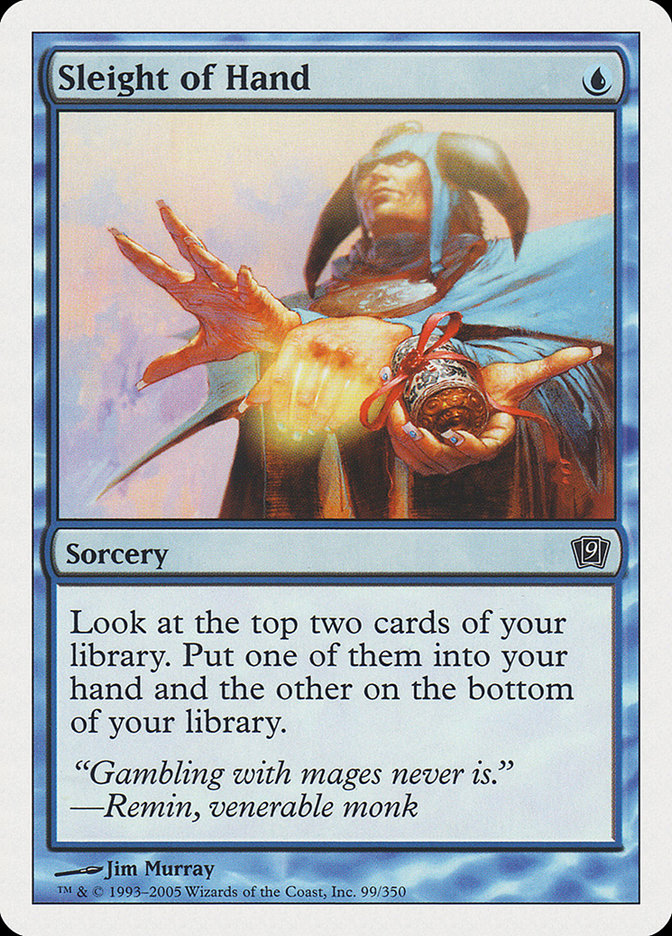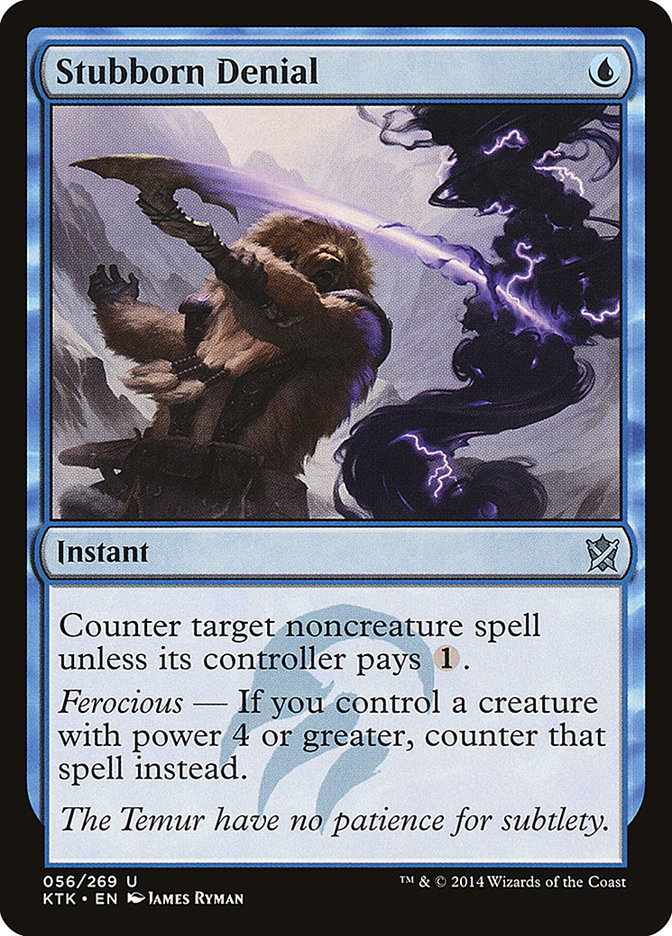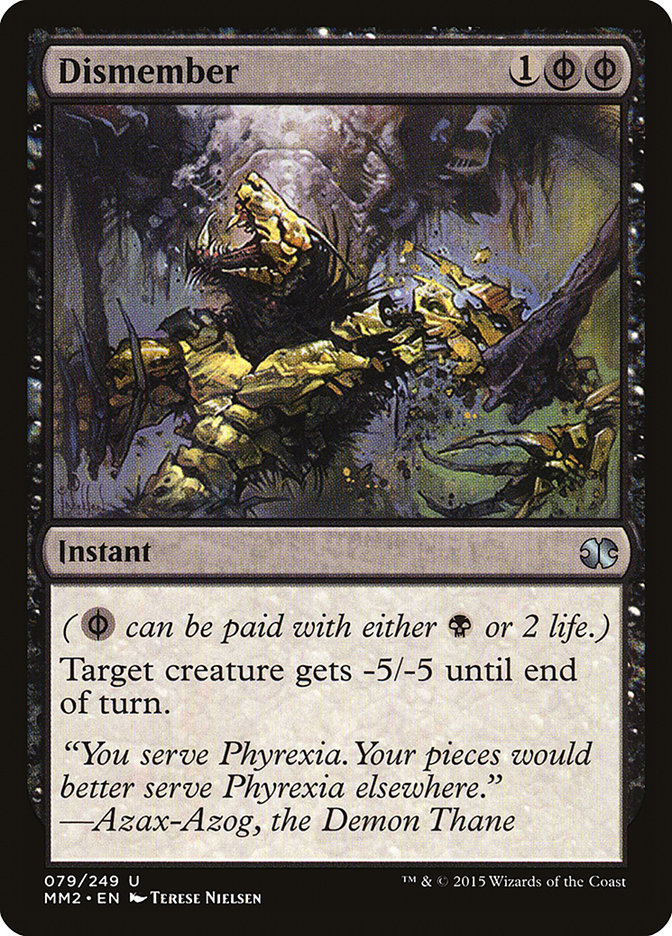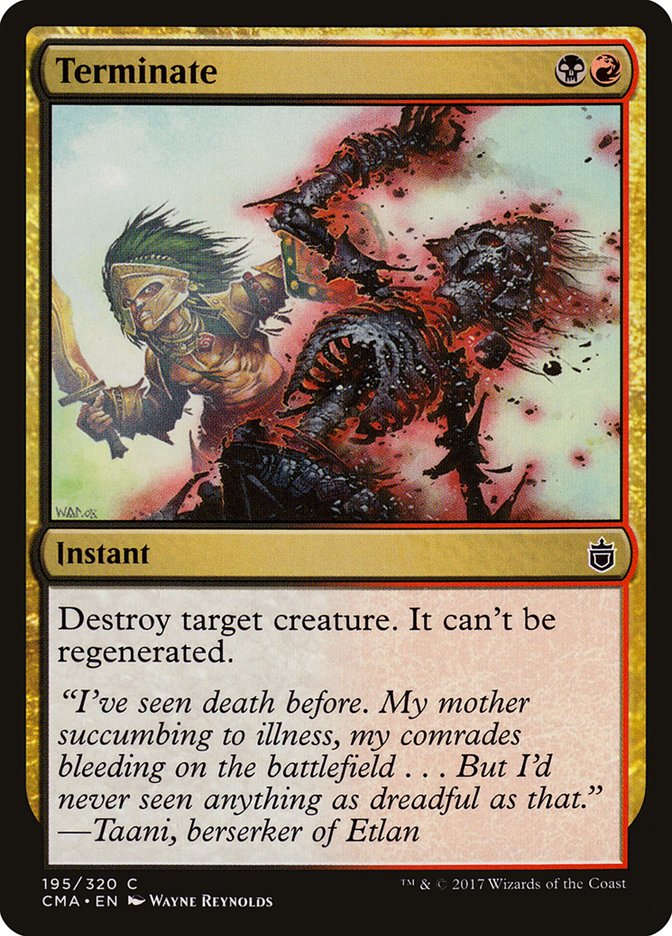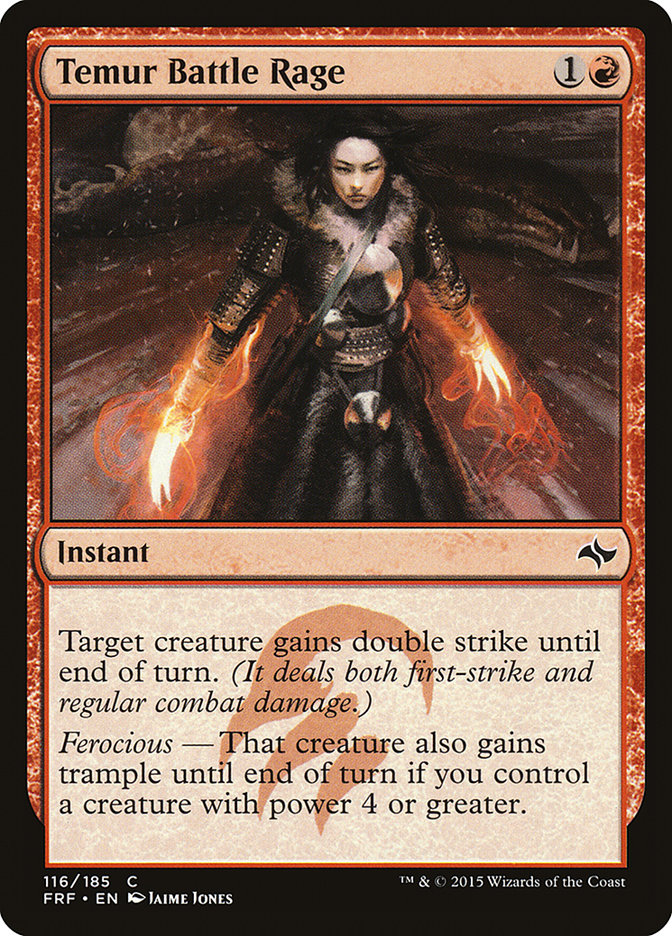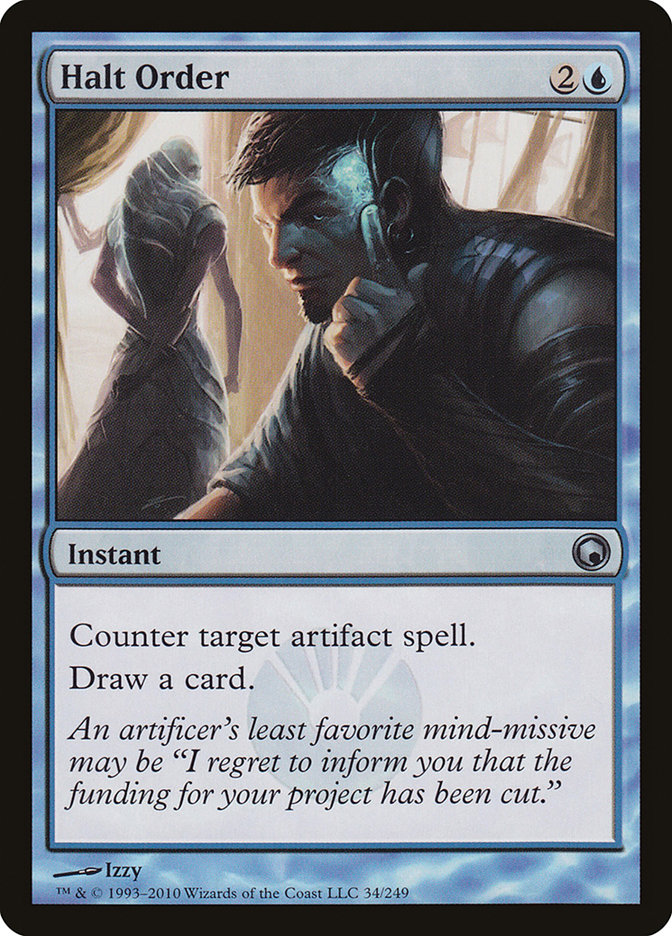I’ve got a bone to pick with Magic’s Modern players: it seems like everyone wants something banned. The lists vary and everybody is upset at a specific strategy, but it’s hard to shake the feeling that everybody has a vendetta against Grixis Death’s Shadow.
There’s a sort of consensus that Grixis Death’s Shadow is not only the best deck, but it’s oppressive. Let’s go ahead and get something out of the way: Modern is in a great place. This isn’t Eldrazi Winter, there are more than three or four realistic deck choices that one can make for a major tournament, and, strategically speaking, Death’s Shadow is very beatable.
I jokingly tend to call Death’s Shadow “Pay Eleven Life Tempo,” and that does a lot of work in summarizing the best ways to beat the deck. If you can out-value the deck without playing a million four- and five-drops or kill the Death’s Shadow player before they can establish interaction plus pressure, you’re in great shape.
I’m not here to talk about the specific ways of beating Death’s Shadow. It’s already been written in hundred different ways. I’m here to talk about the single biggest thing that gives me, a Grixis Death’s Shadow pilot, free wins: my opponents. That’s right, the single biggest thing that gives me free wins with Grixis Death’s Shadow is people either misunderstanding the deck, playing around cards that aren’t there, or getting-got by cards that they didn’t realize were lurking just beneath the surface.
So what’s the best cure for this? Talking about what the Grixis Death’s Shadow decks tend to play, and what certain cards may signal about their deck. “Know your enemy” is the best approach to emerging victorious, and this is an article for reading your Death’s Shadow opponents’ decks, allowing you to tweak your own strategy along the way.
The Shell
There are other articles around the internet that can talk about what Grixis Death’s Shadow’s primary gameplan is and how it functions, so I’ll spare the diatribe and just cut to the chase. These are the cards that every Grixis Death’s Shadow deck plays and are what should be assumed to be in the opponent’s deck:
Creatures (15)
Lands (17)
Spells (21)

From here, there are a handful of flex slots and some things that are important to note about the entire 75. Some cards that the opponent plays will give you clues related to the contents of the rest of their deck.
Maindeck Variations
Generally speaking, Grixis Death’s Shadow can only afford to play about six total three-drops in their deck, and Snapcaster Mage represents between three and four of them. Maindeck copies of Liliana, the Last Hope signal that the Grixis Death’s Shadow pilot is likely playing one or fewer copies of Kolaghan’s Command, and the reasoning is academic.
Liliana is very similar to a reusable Kolaghan’s Command, but she locks her caster into “kill a creature/Disentomb” modes. If a player is looking to maximize these abilities, they’re not going to skimp on Snapcasters, as the combination with Liliana’s -2 is a hard combination to out-grind from the perspective of a fair deck.
To my knowledge, Ari Lax and Danny Batterman were the first people to add this technology to the deck at Grand Prix Las Vegas, and Ari has already touched in its inclusion at the end of this Premium article.
What’s important is that seeing Sleight of Hand from Death’s Shadow absolutely gives you information, and it varies depending on how many copies of Sleight of Hand they cast.
Creatures (16)
Lands (18)
Spells (26)

People are beginning to play a single Sleight of Hand and shave a Blood Crypt to make room. These decks aren’t incredibly different from the stock lists that can be found around the internet, but the lowered number of red sources is noteworthy.
Creatures (15)
Lands (17)
Spells (28)

What Ari’s camp is doing is going down two lands, shaving a fetchland and some number of the three-mana spells in the deck. The primary signal here is the opponent casting a second or third copy of Sleight of Hand. Jonathan Rosum played a version of the deck with two copies of Sleight of Hand, but that’s atypical at this point, and I would err towards assuming it was a build closer to Ari’s list than Jonathan’s.
Always assume that a Grixis Death’s Shadow has at least two copies of Stubborn Denial in their maindeck, with a total of four copies in their 75. I tend to err towards playing three in the main, but that’s just a preference in how I play the archetype more than something that one should blindly emulate.
At the most recent #SCGCHAR, Dismember began making an appearance in Grixis Death’s Shadow lists and it hasn’t really disappeared. What people are tending to do at this point is play a split between Fatal Push and Dismember, rather than completely overloading on removal. Previously it was safer to assume that Dismember was an additional removal spell, but at this point it is much safer to assume that a Death’s Shadow player has six total hard removal spells.
Generally speaking there is at least one copy of Terminate and three Fatal Pushes, but from there it’s a bit foggier and depends on what bases a player wants covered.
If the goal is just to be streamlined, the four Push/two Terminate configuration is a great place to be. There’s a reason those are the most commonly played removal spells in the deck.
Lightning Bolt is great at hitting things that people like to think of as anti-Shadow. Mirran Crusader is definitely a problem, and having a way to kill it is nice. The Bolt-Snap-Bolt line is also a great way to close the door against some of the decks that are harder to interact with.
Dismember is starting to show up in place of the fourth copy of Fatal Push due to it being a one-drop removal spell most of the time, and it having more applications in some matchups where Fatal Push may otherwise be dead. Having one more spell to hit Reality Smasher and Gurmag Angler is really nice. The biggest issue with Dismember is that it is really awkward with Snapcaster at times. The life is also an issue for some of Death’s Shadow’s draws. Consider this hand:
This type of hand is really going to have trouble utilizing all of its resources due to the amount of life that it has to pay. This is an extreme example, but over the course of a longer game, Street Wraiths and Thoughtseizes add up. An early Dismember versus Fatal Push can determine the difference between these spells being playable and completely uncastable.
Most of the cards that can pop up in Death’s Shadow variants are going to be oddities rather than rules of thumb. Daniel Fournier’s main deck from his #SCGINVI finals berth is one of the only places where you’ll still find copies of Rise // Fall:
Creatures (16)
Planeswalkers (2)
Lands (19)
Spells (23)

Sideboarding
This is where things get funkier, and a little harder to read. Most of these things are going to tell you what cards your opponent isn’t playing, which will in turn lead you to what cards they are playing, by process of elimination.
The sideboard itself is relatively formulaic, but generally has:
- A two-drop creature removal spell
- Two to three midrange spells
- Three to six anti-graveyard cards
- Three sweepers
- Two to four copies of artifact hate
- One to three copies of Collective Brutality
- Zero to two copies of Temur Battle Rage
The easiest thing to dissect is the sweeper suite that Death’s Shadow decks have in the sideboard. A majority of Death’s Shadow decks are going to have the single Izzet Staticaster, but then a combination of two copies between the others. Are there patterns from there? Absolutely!
If a player is playing Flaying Tendrils, it signals that they value the exiling that Flaying Tendrils provides, yet don’t want to play Anger of the Gods. Sure, Flaying Tendrils is able to deal with Etched Champion and Master of Waves, but it also doesn’t deal with x/3s, so why would they choose to play Tendrils instead?
It doesn’t require two red sources of mana to be cast.
Flaying Tendrils tends to show up in variants of the deck that are playing one Blood Crypt and one Steam Vents. Casting Anger of the Gods in these decks isn’t a trivial issue, and if there are only two total red sources in the deck, it can be pretty risky targeting yourself with a Thought Scour. Flip over a Steam Vents, and all of a sudden, two of your best sideboard cards are completely uncastable.
As a general rule of thumb, people playing Anger of the Gods or Flaying Tendrils are playing them in order to make use of their exile effect, and play multiple copies as a result. If you see one Anger of the Gods, it’s generally expected for them to have another.
Pyroclasm, Kozilek’s Return, and Engineered Explosives, on the other hand, tend to be played as singletons. Players diversify their assets a bit with these cards and want to make sure all of their bases are covered. Pyroclasm is the cheapest sweeper but doesn’t really have a lot of upside against some of the problematic creatures of the format. Kozilek’s Return is the best at killing things (including creature-lands), but it is three mana for a two-damage sweeper, and it doesn’t keep things dead, so to speak. Engineered Explosives is by far the most versatile of the sweepers, but it comes at the cost of being expensive and clunky, and as a result, the Death’s Shadow decks can’t really afford to sideboard multiple copies.
These are the most common midrange breakers in order from most commonly sideboarded to least likely to see from an opponent. Liliana, the Last Hope tends to be fantastic against other midrange decks due to her ability to rebuy threat after threat combined with the inevitability of her ultimate. The biggest issue with her is that she is fragile if her controller is behind, and her +1 doesn’t tend to impact other nonwhite midrange decks very well.
Kolaghan’s Command sees the next-most amount of play due to its versatility. Most of the things that Kolaghan’s Command aren’t necessarily the most efficient form of that ability, with three mana being a very real cost, but the fact that it can do so many things is a real benefit.
Liliana of the Veil is a card that is much, much stronger than Liliana, the Last Hope, but doesn’t play quite as well in this strategy. The largest issue with Liliana of the Veil is that she doesn’t play particularly well with the blue cards in the deck. Cantrips make it harder to empty one’s hand, Stubborn Denial is a card to keep in hand, and Snapcaster Mage tends to be at its best when it’s sandbagged until the later turns of the game. All of these make it more difficult to benefit from her +1, despite her being a more powerful card in a vacuum than Liliana, the Last Hope.
Painful Truths is the last card on the list and felt worth mentioning, despite making rarer appearances. Painful Truths is nice in that it provides cards and a way to pay life, but raises the issue that it doesn’t play particularly well in a tempo strategy. Most of what this deck is trying to do is during the opponent’s turn, and tapping out for something that doesn’t play to the battlefield has a very real cost. I don’t love Painful Truths myself, but I understand the allure of the immediate card advantage that it brings.
This one is relatively easy, so we’re gonna rapid-fire it.
Nihil Spellbomb is great because it wipes their entire graveyard without knocking you down a card. The biggest issue with it is that it costs the most mana of all the options available. Technically the card can cost a single mana if necessary, but if that were the ideal scenario, Tormod’s Crypt would see more play.
Leyline of the Void is one of the best options because it’s continuous and doesn’t require a mana investment…until it does. It’s absolutely horrid to draw anytime after the first turn and is incredibly swingy. If a Grixis Death’s Shadow player has a Leyline of the Void or mills one via Thought Scour, it isn’t absurd to assume that they end up with a copy stranded in their hand over the course of the game.
Playing Leyline of the Void could signify a couple of things. The first thing is that they are playing multiple copies, and the numbers are likely closer to the three-four range than the one-two range. The odds of opening up with a Leyline of the Void drop off pretty drastically when there are fewer than three of them. The second thing that it puts on my radar: cards that benefit from discarding. Leyline of the Void being such a bad draw generally means that someone registering it will also include things to do with redundant copies that end up in their hand. Liliana of the Veil and Collective Brutality are much better in Grixis Death’s Shadow lists with cards with the kind of diminishing returns that Leyline of the Void boasts.
Surgical Extraction is technically graveyard hate, but its pointedness makes it serve a different role from something like Nihil Spellbomb. Nihil Spellbomb is something that’s good against matchups sporting Delve cards or against Grim Flayer decks, but is weaker against something like Ad Nauseam. Surgical Extraction is great against the hyper=linear combo decks and decks that use targeted abilities on their graveyard.
That being said, Surgical Extraction is likely the single most over-sideboarded card in all of Magic right now. If there isn’t a specific purpose of a Cranial Extraction-meets-Purify the Grave effect, don’t bring it in. Snapcaster Mage isn’t a good enough reason to sideboard Surgical Extraction. The purpose of Snapcaster Mage is the generate card advantage, and if you’re putting cards like Surgical Extraction in your deck, you’re adding a card that doesn’t actually provide an advantage (unless you get lucky and snipe additional copies of the targeted card out of the opponent’s hand), and cost a card in the process. It’s actually playing right into the gameplan of the Snapcaster deck. Don’t fall for it.
Grafdigger’s Cage is the last commonly played graveyard hate card out of Death’s Shadow, and I have a hard time justifying it. Turning off one’s own Snapcaster Mages just isn’t something that I can get behind. The draw to Cage is that it has splash damage against Collected Company and Chord of Calling, but without those decks running rampant, it feels like the sideboard slots that are dedicated to Grafdigger’s Cage could be dedicated to something that doesn’t hurt one’s own gameplan.
There’s a single slot in the sideboard that is dedicated to a single removal spell that does something on top of a Fatal Push or a Stubborn Denial in matchups where those cards are weaker. It is generally occupied by the third copy of Collective Brutality or one of the Rakdos-flavored two-drops.
If Surgical Extraction is the most overplayed card in Modern right now, Collective Brutality is likely second. At this point I feel like I’m including it in my decks out of obligation and common acceptance more than actual desire to play the card. It’s great against Goblin Guide and Noble Hierarch, I get it. Otherwise it’s an overcosted removal spell, a bad Duress, and another mode that is technically printed on the card.
The debate between Terminate and Dreadbore comes down to which flavor of versatility the Death’s Shadow pilot prefers. Terminate is great in that it doesn’t require its caster to tap out on their turn. Dreadbore is great in its ability to take out Karn Liberated, Liliana of the Veil, and Nahiri, the Harbinger.
The choice of artifact destruction is more or less contingent on how much space the Death’s Shadow player can dedicate to Eldrazi Tron as well. Kolaghan’s Command is great in that it pulls double-duty against the midrange decks. Ceremonious Rejection is nice because it also does work against Thought-Knot Seer and company.
By Force is better than Vandalblast at the moment due to its ability to destroy Chalice of the Void, and I wouldn’t stray from it as a result. It’s worth noting that By Force is only worse than Vandalblast in two situations: when it is destroying exactly one non-Chalice artifact, and when the opponent controls five or more must-destroy artifacts. Otherwise, By Force is going to be more efficient.
Hurkyl’s Recall goes in and out of popularity as an anti-artifact card, and I’m of the opinion that it is fine against Affinity, but amazing against Lantern Control. The draw to Recall over By Force is that it gets around both Welding Jar and Padeem, Consul of Innovation. It will likely take a Lantern player two or three turns to re-deploy all of their cards, and that is enough time to kill the opponent, assuming the Death’s Shadow player has any semblance of reasonable pressure.
Temur Battle Rage is good for one thing: getting ’em dead. The places that Temur Battle Rage tends to shine are against decks that are resource-heavy, meaning that the decks that aren’t interacting very much are going to be the most vulnerable to a card that is as powerful as Temur Battle Rage, despite its fragility. The creature-heavy decks and the non-interactive combo decks are where Temur Battle Rage shines the most, and if those decks are something that a Death’s Shadow player wants to beat, Temur Battle Rage is one of the best cards to do it.
It’s hard to figure out what kind of interaction is the best to play on a given weekend, but you don’t have to interact with the opponent if they’re dead.
Who Is All of This For?
Honestly, this article was at least a little self-serving in that it helped me break down Death’s Shadow lists to a formula. I’m playing the deck at #SCGNY and #SCGRICH, after all. A lot of what this is for is to help frame why certain cards make other ones better during the deckbuilding process. Sure, you may not be looking to play Collective Brutality after I spent a few hundred words dragging it, but the takeaway from discard outlets’ increased value and cards with diminishing returns is something with applications in every format.
Death’s Shadow is incredibly streamlined at this point, and there aren’t a whole lot of curveballs to be thrown. I’m expecting a new version of Death’s Shadow to become more popular more than I am expecting someone to reinvent the Grixis Death’s Shadow wheel in the next couple of weeks. This places a higher value on strapping in, learning the finer aspects of Grixis Death’s Shadow, and getting the reps against everything that people are doing with it.
Reinforcing this information now will dramatically increase your win rate in competitive Modern events. After all, Modern is a format that rewards familiarity.




